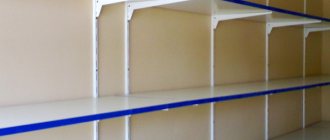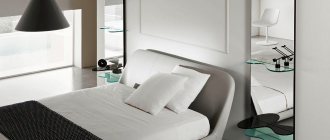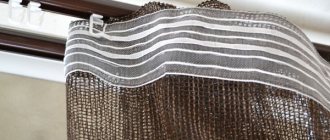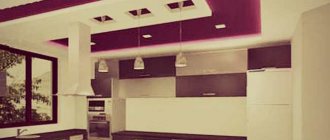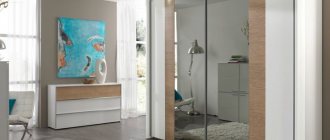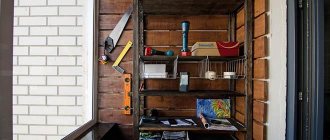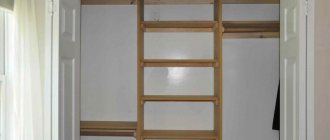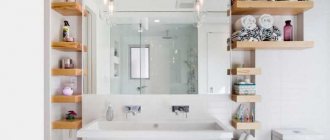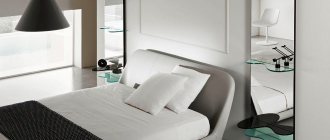Despite its versatility and a lot of positive characteristics, drywall has one specific feature: it is quite fragile under load. As a result, it is recommended to mount the material on a frame with an appropriate number of fixation points.
An example of installing kitchen cabinets on plasterboard. If you do not know the technology for attaching heavy objects to plasterboard, this can lead to deformation and even destruction of the finish. However, taking into account the specifics and choosing the right ways to solve the issue, you can solve the problems that arise with hanging elements on such a fragile material without any difficulties.
For lightweight structures
Not only an experienced, but also a novice craftsman can hang shelves on a plasterboard wall. To do this, you need to use one of the 5 main ways to carry out this work. The choice of one of them depends on the characteristics of the attached product, its size and weight.
Method 1: glue installation
Attaching a shelf to a plasterboard wall is not as easy as it might seem at first glance. The main problem that the master faces is the fragility of drywall. Due to excessive load, the material may begin to crumble and gradually lose its strength. To prevent damage, it is necessary to use special devices and materials during installation. Among them, glue is considered one of the most popular. With its help, you can secure plasterboard shelves on which only light objects will lie.
- On the wall, with a pencil or marker, mark the places where they plan to place the shelves.
- Contact adhesive is applied to these lines. Its layer should be as even and thin as possible.
- The same adhesive composition is applied to the back side of the attached object.
- The product is pressed against the wall and held for several seconds. The holding time depends on the characteristics of the glue used.
- Leave the structure for several hours until the adhesive has completely dried.
- After this, the shelf is tested for strength by placing various light objects.
Method 2: fastening with self-tapping screws
If you don’t want to use glue and wait a long time for it to dry, you can attach the shelf with self-tapping screws. The finished structure will be a little stronger and will be able to support larger objects.
- Determine the location of the shelf.
- Make the appropriate marks and lean the structure against the wall.
- For single-layer sheathing, use screws for metal or wood with a length of 25 to 35 mm, and for two-layer sheathing - at least 60 mm.
- Tighten the fasteners with a screwdriver or an ordinary screwdriver.
While the work is being carried out, it is forbidden to unscrew the screws and return them back. If you make such a mistake, the carving will destroy the plaster and the shelf will not adhere well to the wall. A similar problem occurs when screws are overtightened.
Plasterboard shelves
Shelves are a functional detail of any interior
If you know how to make plasterboard shelves with your own hands, but are unsure of your knowledge of installation methods, it is better to use a “Molly” type mount made of metal. These fasteners come in different types and designs, with hooks, screws and nuts, and caps at the end. Choose those that open on four sides.
Fasteners should be selected in accordance with the thickness of the base. Then a hole of the required size is drilled in the drywall. Using special mounting pliers, the dowel is inserted into the previously prepared hole. After this, the screw is screwed in using a screwdriver or screwdriver.
Making a shelf
For this you will need:
- construction level-rail;
- construction knife;
- screwdriver;
- “Molly” or “butterfly” fastenings;
- profile 50×25 mm;
- slats;
- frames;
- traverses;
- pencil;
- plumb line;
- sandpaper;
- electric plane;
- putty knife;
- roulette;
- rule;
- wire cutters;
- pliers;
- Molly installation tool;
- hammer;
- putty grater, electric or manual;
- respirator;
- gloves;
- protective glasses;
- bucket;
- metal scissors or grinder.
Assembly instructions:
- Develop the design of the future shelf, determine its dimensions.
- According to the drawing, attach the profiles to the wall.
- Make a frame that is strengthened with traverses and frames.
- Embroider the sheets of drywall, cutting the pieces to the required size. (see also the article Do-it-yourself drywall finishing: installation instructions).
- After this, the shelves must be plastered outside and inside, painted or covered with decorative plasters. (see also the article Finishing putty for drywall - all the main points).
Shelves are an indispensable attribute
For heavier shelves
To hang heavy objects on drywall (for example, not just one shelf, but a large rack), you need to use special fasteners. They will more securely fix the structure and reduce the likelihood of it falling.
Method 3: expansion and expansion dowels
The easiest way to hang a heavy shelf is with dowels, which you can buy at a store that sells repair supplies. The cost of these fasteners is high, but without them it will be impossible to attach heavy objects to a plasterboard wall.
Correct sequence of actions:
- Mark the places where the fasteners will be screwed.
- A hole is made in the plasterboard wall, the diameter of which will be slightly smaller than the size of the dowel. This job can be done using a hand or electric drill.
- The fastening element is carefully hammered into the wall.
- The rack is attached to the wall.
- Tighten the locking screw, which will open the inside of the dowel and increase the area of load distribution.
Method 4: Through Anchor
This device is used only when it is impossible to use expansion or expanding dowels. This situation may arise due to the small distance between the wall and the sheathing. You can attach a shelf to drywall using a through anchor in a few simple steps.
Installation instructions:
- Use a simple pencil to mark the location of the shelf.
- Drill a hole whose diameter will be equal to the size of the fastener used.
- A slot for the anchor sleeve is made in the load-bearing wall using a hammer drill.
- A metal or plastic sleeve is inserted into the resulting hole.
- Tighten the locking screw. As a result of these actions, the sleeve will open, and the entire load will fall on the concrete wall.
- After this, hang a shelf and place various objects on it.
Method 5: mortgage
So that after the completion of the repair there is no need to attach the shelves to the drywall, you need to foresee their presence on the wall in advance. To do this, install a special embedded beam to which all structures will be attached.
- When installing the frame, choose the location of the rack.
- At these points, a thick board or timber is attached to the load-bearing wall. This is done using a through anchor. In this case, the thickness of the structure should be such that there is a minimum gap between it and the casing.
- After completing the finishing of the walls, the locations of the racks of the embedded structure are marked on plasterboard.
- A shelf is attached to them using ordinary self-tapping screws.
- The installation of other products is carried out similarly.
To hang shelves on a plasterboard wall, you need to put in a little effort and spend a few tens of minutes of free time. If mistakes can be avoided during this work, then the attached rack will perform its functions for a long time and delight the owners with its appearance.
Installation of decorative shelves, paintings, light lamps
For these purposes, using dowels with a butterfly end does not make sense, but you cannot use a simple self-tapping screw either. In the first case, the fasteners will be too massive, in the second, unreliable. If the self-tapping screw is only screwed into plaster, it will quickly become loose, destroying the material. Even if it hits the profile, sooner or later the fastener will begin to reach.
You should use a special dowel for drywall. It has the shape of a truncated cone and wide-profile threads with a large pitch. The diameter is often up to one centimeter. These dowels are called DRIVA or snail dowels. There may be dowels with or without a drill at the end, metal or nylon.
For drywall, DRIVA nylon dowels with a drill at the end and a length equal to the thickness of the drywall sheets on the wall, no more and no less, are best suited. They have a cross-shaped groove at the end for easy tightening using a Phillips screwdriver.
- The locations of the fastenings are marked at the central points.
- Using a screwdriver and a cue ball with a cross-head bit, screw in the dowel until it stops.
- A shelf or other element that needs to be secured is leaned against and a self-tapping screw with a press washer is screwed in.
It all comes down to using only special fasteners for drywall, which are not more expensive than usual, but provide reliable fastening and do not create preconditions for cracking and destruction of the gypsum inside the material. You can hang almost anything on drywall, as long as you take into account its strength and follow simple instructions.
Do not forget that during drilling a large amount of dust is generated, especially considering the composition of a material such as drywall. You will need to worry about protecting the room from dust, as well as personal protective equipment when carrying out such work. You can attach shelves to a plasterboard wall using special dowels.
Such fasteners can be of various types, but one of their advantages is that when screwed into the wall, they begin to open, thereby forming sufficient support and taking on a significant part of the load. To secure such shelves, a special design will be required; firstly, it will be necessary to mount the structure strictly in the profile of the plasterboard sheet, and secondly, the use of special fasteners.
- Its installation will require quite a bit of time;
- Thanks to the use of dowels, it is quite durable as long as the shelf is used properly.
Advice! The screws are screwed in with a screwdriver, but not completely. The final screwing must be done with a Phillips screwdriver, with a little force.
- Glue – you can glue a light weight shelf, which will serve as a decorative element. This could be a shelf with a figurine of “Venus”, with a small beautiful picture;
- Dowel-nails - the shelf can be made of lightweight material. It is possible to put car and apartment keys, a mobile phone and other light essentials on it;
Typically, plasterboard walls are sheathed in one layer. The sheet thickness is 12.5 mm. When you are renovating a room, think in advance about whether there is a need to place heavy objects on such a wall. If yes, then do not skimp on making the wall with two layers of gypsum board.
Then its resistance to shelves, equipment or paintings placed on it will almost double. We select the size of the dowel based on the dimensions of the protrusion and the expected mass of things that we plan to place on it. The larger both parameters are, the longer the dowel - the nail will have to be used. Today we will talk about how to attach a shelf to a plasterboard wall if the plaster crumbles and cannot withstand this kind of load? Important! If the dowel is difficult to drive, bends or breaks, take another drill or drill a hole. The dowel should go to the full depth of the hole. Today, not only ceilings are covered with plasterboard, but also walls are leveled. Although this material has a number of advantages, it still has a small drawback - fragility when hanging heavy objects on it: shelves, cabinets, paintings, etc. Therefore, the question very often arises “how to hang a shelf on drywall”? Please note !
The drawing must indicate not only the dimensions of the wall and the shelves themselves, but also the distance between them, as well as the distance to the floor. When creating a diagram, you need to take into account both the placement of shelves on the wall and their functional purpose.
Who could hang a heavy shelf on a plaster wall? Share!
Has anyone managed to do this? Shelf - 16-17kg, wall made of gypsum plaster with rare diagonal wood. slats. Tiled.
on the anchor you can!
Ilna wrote: a wall made of gypsum plaster with sparse diagonal trees. slats.
Unclear! How can a wall be made of gypsum plaster? The wall can be made of gypsum blocks. Photos and drawings with dimensions make it much easier to understand.
The walls are already covered with tiles, the wall is so soft that it can be drilled in no time. When I removed the old oil. paint and some layers of plaster crumbled, wooden slats laid diagonally became visible. This happens, maybe you just haven’t encountered it. The slats go through 400mm. The foreman who was called to hang the shelf clicked his tongue and disappeared))))
most likely it won't work
Ilna wrote: the wall is so soft that it can be drilled in no time
try using fasteners for gypsum boards, although 17 kg is steep.
Sergey Sazonov wrote: most likely it won’t work
I think so too. How do you like chemistry? do you refer to fastenings? And if you hang the metal first. a rail for several attachment points to “spread” 17 kg. Is there already a shelf for this rail? Who in the store thought it was so heavy?
“diagonal slats” are shingles, they were usually stuffed onto a wooden wall for plastering. try to drill deeper, maybe there is wood there?
as an option, in order to eliminate doubts about the reliability of fastening, make stops to the floor, decorative shelves to match.
ClubMD wrote: try to drill deeper, maybe there is wood there?
They drilled right through when they attached the sink. NO wood, just loose plaster.
Ilna wrote: What about chemistry? do you refer to fastenings?
just not in your case
Ilna wrote: And if you hang the metal first. a rail for several attachment points to “spread” 17 kg. Is there already a shelf for this rail?
This is an option, but you know better how it will look from an aesthetic point of view. If the sink has been secured and is holding, proceed in the same way. Can I drill it through and fix it on the back side of the wall?
ClubMD wrote: make the stops to the floor
then it’s better to take the side racks and lower them to the floor, and instead of a shelf, make a bookcase
It seems the situation is hopeless.
Ilna photos, pictures, layout, maybe we can give you some advice. original design solution))
Ilna wrote: The walls are already covered with tiles, the wall is so soft that it can be drilled in no time. When I removed the old oil. paint and some layers of plaster crumbled, wooden slats laid diagonally became visible. This happens, maybe you just haven’t encountered it. The slats go through 400mm. The foreman who was called to hang the shelf clicked his tongue and disappeared))))
The plaster did not have time to dry, which is why it is soft. Laying tiles slows down the drying of the plaster. Try to wait. drill holes for the dowels and wait a month or two. third. If you can’t wait, call the person who laid the tiles on wet plaster and make him clean the grout from the seams - the drying process will be more fun!
Ilna wrote: the master for hanging the shelf clicked his tongue and disappeared))))
Didn't he have a tile drill? - in principle, I could drill it silently and hang the shelf. She would have held on. But then the tile could move away from the wall (“boom”) with some degree of probability.
- in principle, I could drill it silently and hang the shelf. She would have held on. But then the tile could move away from the wall (“boom”) with some degree of probability
How to hang a shelf on a plasterboard wall: 5 installation methods
If the wall is covered with gypsum board, then you need to hang the shelves using special fasteners
The question of how to hang a shelf on a plasterboard wall has several possible correct answers. It all depends on what load the structure will place on the gypsum plasterboard sheathing, and what materials we will have at our disposal.
I will tell you how you can hang lightweight shelves with minimal labor, and also describe the technology for installing heavier structures.
For lightweight structures
Method 1. Adhesive installation
Once the paneling and finishing are complete, we may be wondering how to attach a shelf to a drywall wall. The problem is that drywall is a rather fragile material, and therefore it will crumble under load. This means that when hanging shelves we will have to use a variety of devices that will allow us to compensate for this shortcoming of drywall.
Such shelves can be attached with glue
The choice of fastening method directly depends on two parameters:
- The weight of the shelf itself.
- The planned load on it.
We will build on them when planning our work.
This composition is quite suitable!
For decorative shelves, stands for small photographs or keys in the hallway, you can use adhesive mounting. This method is the easiest to implement:
- We apply markings on the wall for installing a decorative object.
- Following the markings, apply a thin layer of contact adhesive to the surface covered with gypsum board.
- Apply the same layer of glue to the back of the shelf.
- Let the glue sit for some time (depending on the type of composition) and press the shelf against the wall. The pressure should be tight, but not too tight: it is advisable to dose the force so as not to crush the drywall.
If you don't put too much pressure on it, the glue will hold!
The described method requires virtually no labor costs, but its reliability is low.
Method 2. Fastening with screws
If we are dealing with a structure whose mass is small, but does not allow the use of the adhesive method, we can simply fix the shelf with self-tapping screws. The choice of fasteners depends on where we will carry out the work:
If you don’t load it, then a shelf like the one in the photo holds perfectly on four self-tapping screws
- if the shelf will be installed simply in drywall or in a wooden frame element, then we use wood screws (black);
Such fasteners hold well in a gypsum layer or in a wooden frame
- if the position of the shelf can be adjusted so that the fasteners fit into the metal profile under the casing, we use metal screws with a drill.
The length of the self-tapping screw must be sufficient to completely go through the gypsum board and penetrate into the wooden beam or steel profile. For single-layer sheathing, it is advisable to use elements from 25–35 mm.
The instructions for performing the work are extremely simple:
The fastener with the drill is well fixed in the metal profile
- Select the installation location. As I noted above, it is desirable that the fasteners fall either into the vertical posts of the frame or into the horizontal cross members.
- We put marks on the wall.
- Place the shelf against the wall and tighten the screws according to the marks. It is advisable to use a screwdriver: this way the hole will not “break”.
The correct screw depth will ensure a secure fit.
If tightened too tightly, the reliability of the fastening may decrease due to the integrity of the cardboard layer. And it is also undesirable to unscrew the screws and re-tighten them back: the thread destroys the plaster, and when re-attached it will hold much worse.
Method 1: glue installation
For small shelves and photo stands, you can use an adhesive installation. To hang a shelf on drywall, you need to prepare a suitable adhesive in advance.
Then do the following:
- Marks are made on the wall surface to install the shelf.
- Then, according to the completed markings, a layer of glue is applied.
- A layer of glue is also applied to the back of the shelf.
- Now you need to wait a little and press the shelf against the wall (do not press it too tightly so as not to damage the drywall).
This method is simple, but the strength and reliability of this design is low.
For heavier shelves
Method 3. Expansion and drop-down dowels
Now let's figure out how to hang a heavy shelf. Here, ordinary self-tapping screws are not enough - it is advisable to either use special dowels or solve the problem in other ways.
Let's start with a description of special fasteners - fortunately, they are available on the market in a fairly wide range:
A lightweight, two-blade dowel that fits into a pre-drilled hole.
Plastic or metal dowel with deep thread. Installed by screwing it into drywall along a starting hole with a diameter of 5–6 mm.
It is made of plastic, consists of a sleeve with a massive end.
Probably the most popular type of fastener. It is installed in a hole with a diameter of 8–10 mm, while the teeth on the neck are stuck into the drywall.
Perhaps the described mounts have one significant drawback - a rather high price. But if we consider that to hang a shelf we need only a few of these dowels, then this drawback can be considered insignificant.
Fixation scheme using a drop-down dowel
Method 4. Through anchor
However, sometimes you have to decide how to screw a shelf to drywall if the load on it is high, and it’s not possible to use a special dowel. This situation arises, for example, when there is a minimum gap between the sheathing and the wall, which does not allow the installation of a spacer sleeve.
Marking for installation of anchors
Here you can do it like this:
- First, using a drill or screwdriver with a drill bit installed, we make holes in the plasterboard sheathing. The diameter of the holes must be equal to the diameter of the fasteners used.
Here the rigidity of the entire system comes to the fore, so I recommend working with dowels 8–12 mm or more, even if a thinner product is sufficient for reliable fixation. The thing is that a thick dowel will not bend under the weight of the shelf, and the load on the edge of the hole in the gypsum board will be minimal.
First, we drill a hole in the gypsum board, then a nest in the main wall
- Then we replace the drill with a hammer drill and use a drill to make a socket for the anchor sleeve in the load-bearing wall. The depth of the nest must be no less than the distance from the load-bearing wall to the outer surface of the gypsum board.
- We insert an anchor sleeve made of durable plastic or metal into the drilled hole.
This anchor with a brass sleeve is perfect for our purpose.
- We fix the sleeve with a locking screw with a head or hook. When screwed, the sleeve will gradually open, and most of the load will fall on the main wall.
Scheme of fastening to a through anchor
When implementing this method with your own hands, it is worth keeping in mind that both when drilling a nest with a hammer drill and when hanging a shelf, the hole in the gypsum board will increase slightly. So it’s worth installing fasteners in advance - then at the finishing stage we will be able to mask any defects that have arisen.
Method 5. Mortgage
And finally, a universal answer to the question of how to fix a shelf on drywall . If you want the suspended structure to hold tightly, it is better to provide for its installation in advance:
The embedded beam to which all the hanging elements will be attached
- When installing the frame for gypsum board sheathing, we select a place on the wall for installing a shelf.
- In the selected location, we attach a wooden beam or a thick board to the main wall with anchors. We select the thickness of the element so that the gap between its surface and the back of the plasterboard sheathing is minimal.
Tip: be sure to place marks at the level of installation of the mortgage on the adjacent walls, floor and ceiling. This will make your job of finding it easier!
Scheme of fastening to the embedded beam
- After sheathing, we find the mortgage (using marks or tapping the drywall). We hang the shelf on ordinary self-tapping screws, screwing them through the gypsum board into the wood to a depth of at least 40 mm.
- If the shelf is heavy, we use the method described in the previous section. The use of an embedded beam will not only not interfere with the installation of through anchors, but will also strengthen the fastening unit.
Even quite heavy structures can be attached to a wooden beam
Fastening techniques
Let's start with the fact that fastening methods entirely depend on the parameters of the object being hung (dimensions, weight), and based on the data obtained, you can get an answer to the question - is it possible to hang kitchen cabinets on drywall.
Professional techniques
- The most popular and accessible method even for beginners is to attach kitchen cabinets to plasterboard using butterfly dowels and special plasterboard dowels.
When attaching cabinets to the so-called “butterflies”, you need to make holes in the wall and then install the fasteners. When screwing a self-tapping screw into a “butterfly”, the tendrils of this type of dowel spread in different directions and tightly press the installed fastener to the surface of the gypsum board.
Operating principle of the butterfly dowel
If the cabinet is mounted on special dowels, use a screwdriver to screw the dowel into the cavity of the material and only then screw in the fastening bolt (screw). This method allows you to fasten only lightweight structures whose weight with all contents does not exceed 5 kg.
dowel nail; 2. snail dowel; 3. butterfly dowel;
- The second method is to attach kitchen cabinets to drywall using mounting strips. The main feature of this fastening technology is that the mounting strips are attached to a sheet of drywall, and not to the suspended structure. The strips are fixed in several places (both to the gypsum board and to the metal profile located under the drywall). Fixation is done with self-tapping screws.
Mounting rails for wall cabinets
After completing the installation work, you can hang a cabinet on such slats, the weight of which when fully equipped will not exceed 15 kg. But this method has one significant drawback - the use of unaesthetic fasteners that are unlikely to decorate your kitchen.
If you need to hang bulkier and heavier cabinets on the wall, there are other secure mounting options that will help you do the job yourself:
Extended anchor bolts can be used as fasteners - such fasteners will allow you to attach bulky kitchen cabinets and even household appliances to the wall.
In order to secure them, you should drill deep holes with a hammer drill through the drywall at the very base. We insert anchor bolts into the resulting holes and clamp them there using ordinary wrenches.
This method of fastening is relevant only if there are base walls (this fastening option is not applicable for a plasterboard partition);
Anchor Bolt Installation
The price of mortgages is zero - they can easily be made from leftover building materials.
Unconventional fastening methods
- Thus, a heavy kitchen cabinet suspended on a plasterboard wall can be additionally secured to the ceiling using decorative cables;
Hole in the shelf for the cable
- As additional elements for fastening kitchen cabinets, experts often use decorative chrome-plated tubes - they are screwed to the floor and installed in the form of a frame, which bears the weight of the suspended structure;
In order for the hanging cabinets to be mounted as efficiently and productively as possible, several recommendations must be followed:
- Use only those fasteners that have a quality certificate and meet aesthetic standards;
- When marking fastening points, you must use a building level, and not do the work by eye - correct marking will allow you to evenly distribute the load on all fastening points.
If you follow all the instructions and recommendations described above, then you will probably end up with a reliable fastening system that will quietly serve until the next repair.
In addition to cabinets, the presented techniques allow you to attach any other hanging accessories and attributes to the walls (hoods, air conditioners, cornices, curtains and paintings). All of the above work can be carried out without problems by beginners, without the involvement of expensive specialists.
Shelf on plasterboard for various accessories
A little about the features of drywall
Before attaching anything to a plasterboard wall, let's figure out why this material is so capricious. Its very name implies the composition - gypsum and cardboard: thin sheets of cardboard on the outside and pressed plaster on the inside. They choose it because it is non-flammable, insulates sounds well and is very easy to use.
But gypsum is a pressed powder, so the sheets are very fragile and break and crumble at the slightest mechanical impact.
The maximum that a sheet of drywall can withstand is a framed photo or light decoration like an artificial flower. All this can be fixed with a small self-tapping screw, which can be easily screwed in with a hand screwdriver.
How to hang a heavy object on drywall
How can you hang a heavy shelf for dishes on a fragile plasterboard wall that you can punch through with your fist? This is, in principle, possible if you follow just two rules:
- use special fasteners;
- strengthen the structure.
What fasteners are used to attach heavy objects to drywall?
As you already understand, ordinary self-tapping screws are only suitable for light and small objects. Serious weight requires a special approach.
Drywall requires special dowels. Moreover, the attachment point in this case can withstand a load of 10 kg. Accordingly, if you want to load the wall with more weight, there must be more attachment points.
The length of special dowels can be different, but the cross-section is always the same.
PHOTO: freespace.by The butterfly dowel is more reliable, its maximum result in one layer is 10 kg and 25 in two. It is screwed in until the “wings” rest against the wall, creating additional support for fastening
PHOTO: prorab.help The umbrella dowel (molly) is similar to the butterfly, but it has more fixation points on the wall and it also shows excellent results when loaded. One point in double-layer drywall will hold 35 kg
Thus, if you need to attach shelves to drywall, use special dowels, the most reliable of which is the “umbrella”.
Related article:
Self-tapping screws for plasterboard : how to choose, types of self-tapping screws for plasterboard, dependence on the material, on the types of threads, on the coating, on the type of tip, on the purpose, requirements for self-tapping screws for plasterboard according to GOST, leading manufacturers, selection of self-tapping screws for plasterboard.
How to strengthen a plasterboard structure for hanging cabinets
And here there are several options available. The first is to use an embedded beam. The method is fail-safe, but it can only be used in two cases: during repairs or construction. That is, initially, when you make a frame for drywall, you need to understand where and at what height the hanging shelves will be placed, and it is at this height that you need to attach embedded elements made of wood or a metal profile to the frame. The frame is covered with plasterboard on top, and you can easily install fasteners through the sheathing into these same embedded elements.
PHOTO: stroyday.ru Of course, when covering, you need to mark the places of the mortgages so as not to miss when hanging the cabinets
The second option is suitable if the walls are already sheathed and you are not going to dismantle the drywall. The horizontal rail (metal profile) is fixed to the wall with the same dowels mentioned above. The more dowels you use, the more the tire will hold up.
Maximum loads on gypsum boards
If the assembly is based on a frame, with standard sheathing sheets (12.5 mm), then such a wall has a decent margin of safety.
The basis of the entire wall is rack profiles connected to each other and located in increments of 400 - 600 millimeters. This design with a plasterboard sheet can withstand a load of up to 50 kilograms at one point.
But, as a rule, large objects are secured with several fasteners. It follows that if the fasteners are placed evenly every 1 meter, then the suspended object can withstand 80 - 100 kilograms of load.
Even if you hang a shelf with a TV on a plasterboard wall, the distribution of attachment points, combined with the safety margin of the material itself, can easily withstand such a load.
The main thing is to use the right materials and follow the technology for their use.
Overview of drywall fasteners
In order to hang a shelf on a wall with such a finish, various methods are used, but you must use fastening material. The good old option with a nail in the wall will not work here, just like a wooden dowel with a screw.
Such fastenings for gypsum boards are available for sale.
- "Driva".
- "Butterfly".
- "Umbrella".
- "Mole."
- Anchors.
“Driva” is a plastic (nylon) type of dowel with a screw thread on the surface and a length slightly exceeding the thickness of the sheet. The thickness of this fastening exceeds standard dowels, which allows it to be more securely fixed in the material. Each “drive” can withstand a load of 25 kilograms and is perfect for hanging light shelves.
"Butterfly" has two components. Actually the self-tapping screw and a plastic device, which, when the screw is screwed in, opens the wings on the reverse side. This design is securely fixed in the thickness of the plasterboard, and the open stops distribute the load. This hardware also allows you to attach not too heavy objects to drywall.
How and how to screw a shelf to a plasterboard wall
Reading time:
Drywall is increasingly being used to decorate walls. The material has proven itself well: it is easy to work with, and the appearance is quite decent.
Walls are often built from plasterboard.
At the same time, the question arises about attaching various objects to plasterboard walls: how to do it firmly and beautifully.
- Mounting features
- How to Attach a Heavy Shelf Anchor Bolts
Mounting features
When faced with the issue of attaching lamps, hangers or shelves to a plasterboard wall, craftsmen are justifiably afraid that the wall will “react” negatively to such manipulations and will crumble or crumble.
Complex large shelves are difficult to attach.
However, answering the question unequivocally: is it possible to attach objects to a plasterboard wall, we boldly say: it is possible! The main condition for successful work is the correct gluing or fastening of drywall to the load-bearing wall.
The problem is that drywall is a rather fragile material.
If all technological requirements are met, there is nothing to fear. And remember, the maximum load-bearing capacity of drywall depends on many factors. In particular:
- Quality of material;
- Reliability of fastening to the wall;
- Size and weight of attached items.
A butterfly dowel is inserted into the recess through the profile.
To attach light shelves to a plasterboard wall that do not put a serious load on the surface, ordinary screws are sufficient. By the way, hooks in the bathroom for towels or in the hallway for light clothes are also attached with the same screws.
The search for the metal frame profile is carried out using a magnet.
Choosing the right screws is the key to success. The fastening process must be carried out using dowels. Thanks to this, the design will be durable and reliable.
The diagram shows how to mount the shelf.
You can find out which dowels and screws are best to use for a particular load from sales consultants in building materials stores.
One of the most popular methods of fastening furniture involves the use of anchor bolts.
The “secret” of the dowel is simple: during installation in the wall, it opens, placing emphasis on the walls of the structure, and dismantling it becomes extremely difficult. The operating algorithm is as follows:
- We make holes in the wall for installing dowels.
- We install dowels.
- Using screws, we attach hooks or brackets for future hanging items.
- We hang the shelf (hooks, lamps).
Working holes are drilled in those areas where the shelves are planned to be placed.
This method of fastening has strengths and weaknesses. First, about the positive aspects:
- Installation will require a minimum of time and construction skills. Even a beginner can cope with such work.
- If the shelves (hooks) are used carefully and weight restrictions are observed, the structure will last quite a long time.
It is advisable not to heavily load the shelves attached to the drywall.
The obvious disadvantages include:
- Inability to withstand heavy loads.
- It is undesirable to attach large shelves, even if they weigh a little.
How to attach a heavy shelf
How to attach shelves to drywall if their weight is quite large? The method used to install a light shelf will be inappropriate in this case. The drywall may simply crumble or crack, causing the shelf to fall and the wall to collapse.
Make fastenings carefully.
To fasten a structure with a large mass, you need to mount the fasteners directly into the profile of the plasterboard sheet, and also take care of the availability of special fasteners.
The procedure is as follows:
- We make a hole in such a way that both the drywall and the profile to which it is attached are drilled. In order not to make a mistake with the location of the profile, experts recommend using an ordinary magnet.
- Special dowels are installed in the drilled holes.
- Next, brackets or hooks are attached with screws. Important: the screws are tightened only to a certain extent, so that during operation the wall can withstand the load of the shelf and is not deformed by the fastener itself.
When screwing in self-tapping screws, cracks may appear along its edges.
And one more nuance: the mount must be mounted on a horizontal profile. This installation option also has its advantages and disadvantages.
- Ability to withstand heavy loads. If there are plasterboard walls, this is a very significant “plus”.
- Fastenings are selected individually for structures of different sizes and shapes. For example, using this fastening method, you can place a shelf along the entire wall, regardless of the width of the structure.
Choose reliable shelf mounts.
- It will take more time and effort, and at least minimal skills in the construction industry are also desirable.
- If the attached structure is not used carefully, this will lead to the destruction of the entire wall, and not just the plasterboard layer.
Anchor bolts
Another method of fastening is using anchor bolts. To be fair, it is worth noting that this method is known to almost everyone who works with drywall, but for some reason it is used extremely rarely.
In simple terms, anchor bolts allow you to mount directly into the wall through plasterboard sheathing.
Important: this installation option can only be used in cases where the distance between the wall and the drywall is very small.
If you decide to secure something with anchor bolts, then follow these simple recommendations:
- Drill a through hole in the drywall where the material rests on the profile;
- Through the resulting holes, drill additional holes directly into the wall;
- Install the anchor into the wall through the drywall and clamp it;
- To attach shelves or hangers, the anchor itself can be used, or an additional fastener built into it, for example, a bracket, can be used.
The diagram shows how the anchor bolt should be fastened.
Features of this mount:
- Durability, ability to withstand heavy loads;
- With this type of fastening, the drywall experiences virtually no load;
- Installation can be carried out in this way only if the drywall is attached to a metal frame;
- The work process will take a lot of time and effort, since almost double work is carried out: first, holes in the drywall, and then in the wall;
- Compared to previous options, the method is quite expensive;
- If excessive loads are allowed, or the shelf (hanger) is used carelessly, then not only the plasterboard structure, but also the building panel may be destroyed.
Prepare all tools and materials.
Advantages of bolted anchors
Anchor bolts are capable of holding attachments weighing up to 200 kg.
Naturally, plasterboard and its supporting frame do not participate in the distribution of loads, since the main weight is carried by the load-bearing walls. To install an anchor, a hole is drilled in the wall into which the working part of the anchor fastener is inserted. When the screw is screwed in, the anchor body expands, ensuring reliable fastening of the attachment bracket.
The problem is simplified by frameless installation of drywall, which is based on fixing the material with gypsum-polymer glue. The strength of the connection is sufficient to hold the two-layer coating.
Buy components for drywall from the Baustov company at the best prices, and order installation of gypsum boards from experienced specialists to forget about repairs for a long time!
How to choose the right mount
Of course, there can be no clear answers; the question is quite controversial and ambiguous. Much depends on how carefully and in accordance with weight restrictions you are willing to use the piece of furniture attached to the wall.
To attach such shelves, it is enough to use screws.
Which installation option can you carry out yourself, and for which you will need the help of professional builders. Finally, what kind of frame is under your drywall, how correctly is the structure created.
It's easy to attach a small shelf.
If you need to attach a small shelf on which a couple of souvenirs will show off, then you can attach it with dowels directly to the drywall. If the shelf is intended for books and its width is more than 10 cm, then it is better to attach it to the profile.
Therefore, when fastening heavy objects, it is worth using several profiles.
Finally, in the case when you need to attach a shelf to the wall for arranging heavy and expensive items, it makes sense to play it safe and install it directly to the wall using anchor bolts.
Drywall cannot be called a material that can withstand super heavy loads. However, with the right approach to the issue of fastening, even on plasterboard walls you can easily place shelves for books, clothing hangers or small stands for souvenirs.
Do not place heavy objects on such a shelf.
And remember, if you are not sure how exactly the shelf will be used, it is better to give preference to the most reliable mounting method.
